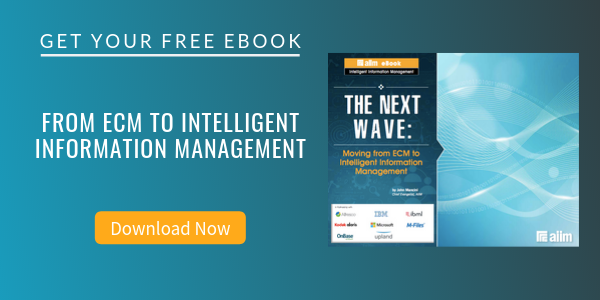
20 Predictions for Information Management in 2015 from the AIIM Board
Intelligent Information Management (IIM)
If you’ll pardon the interruption in MY predictions, I thought I would also share some predictions from the December AIIM Board meeting. I asked each Board member to share ONE prediction about the future as a means to talk about the industry and where it's going and how we (AIIM) serve it. So here goes with a tiny bit of editing and in no particular order…
-
“Will Big Data start to consume ECM in 2015?”
-
“My prediction for 2015 is that it'll be the year that Microsoft gets its mojo back after floundering a bit with Windows 8 and not much on mobile and even screwing up Xbox a bit the last couple years. I think they are finally on to something interesting with the latest Surface device, starting to get some momentum (particularly in the enterprise) there and Windows Phone will get dragged along.
Open sourcing the .NET framework is big (as is official support for Mac and Linux), and maybe biggest of all is the work they're doing with Office 365 and the momentum it is starting to get.”
-
“The structure of the workforce and the way in which people work is changing at a faster pace than companies’ ability to effectively control and manage that change. HR systems that were conceived in the 1990s and implemented throughout the past couple of decades are showing their age. They simply are not designed to effectively deal with the multiplicity of working structures that exist in typical organizations today.
At one end of the spectrum we are seeing long-tenured positions fall away; at the other end we are seeing novel yet highly disruptive crowdsourcing gain traction. There are situations now coming to market that leverage the power of the crowd for ideation work (Mindjet and Hype Innovation, for example), and I expect to see more use of specialized analytics and experimentation with micro task management tools within enterprises in the next year.”
-
“PDF’s capabilities will spawn a new generation of ECM development in which this open-source, ISO-standardized technology is finally leveraged as a common platform for content. In other words, PDF becomes cool."
-
"The Chief Data Officer will become the driving force behind key decisions related to investments to next-generation cloud ECM/Info Governance."
-
"The lines between ECM, CRM and BI will become even more blurry."
-
"Companies will be spending more on Analytics than ever before."
-
“The convergence of BYOD, ID authentication, and access controls is a huge opportunity. Now that most smartphones will have NFC and biometric capability, why wouldn’t an organization want to provide credentials and an app to employees to replace the swipe card for physical access? Taking it one step further, an HDMI connected monitor could have NFC and use the phone’s NFC/bio for access control. Instead of insecure password sticky notes and 3 FTE on Help Desk to reset passwords for the 20 apps an employee needs and the 400 apps IT supports.”
-
“I believe that 2015 will be the year of business flows. Customers and vendors alike will start looking at all the different solutions they have been deploying over the years, seeking greater efficiencies and business growth accelerators. This will be achieved by connecting together a set of what are today discrete applications into comprehensive business flows.
Take the procure-to-pay business flow as an example: it consists of a broad spectrum of applications including e-procurement, contracts management, supply chain management, invoice processing, etc. Usually, each of these applications comes from a different vendor, and their integration is rather limited.
In 2015, we will start talking about business flows as a way to look at these applications holistically. This is very analogous to what ERP did to structured data a few decades ago, but now it’s the time of unstructured data and processes. Over the next few years, business flows will be consolidated on all layers of the architecture—from user experience all the way down to the data model. It might take the industry several years to accomplish, but it will start in 2015."
-
“I think that managed content solutions will suffer at the hands of a glut of free or nearly free storage options, and we will end 2015 closer to a cloud-based K:Drive than cloud-based ECM. I sincerely hope that this prediction suffers the fate of most of my predictions and is proven wrong by a landslide.”
-
“Traditional ECM vendors will refresh their value propositions to align with the more compelling advantages derived from applying analytics to 'smart' (well organized) content.”
-
“As SMB customers embrace migration to the cloud, virtual file share providers will add ECM functionality to their offerings.”
-
“2015 provides the opportunity for a breakthrough in understanding that better information is central to efficient operation, new projects, and even divestment of assets. Will information management actively step up to the challenge or passively yield to the pressures? My prediction is that 2015 will be marked as the year when IM stepped into the light. IM has tended to appear quite generic and is treated as a cost center, and that has to change.”
-
“In 2015 the #1 new and fastest-growing "smart content/process app" will be in the customer engagement/feedback solutions space - customers interacting directly via social media channels using mobile devices and submitting unsolicited content that makes a difference to companies and how they do business.”
-
“In 2015, the federal government, despite gains attributable to OMB/NARA directive M-12-18 and the amendments to the Federal Records Act signed by the president on 26 November 2014, will struggle to seize the opportunities afforded from its copious information. Despite public attention in the cases of the VA and the IRS, information opportunity will not gain enough traction as a political issue for significant improvements to occur."
-
“Artificial Intelligence will Challenge the very Fabric of the Human Condition -- Late last year, researchers created an electronic link between the brains of two rats separated by thousands of miles. This was a reminder that technology will one day make some of us telepaths and change the very fabric of the human condition.
We have sufficient hardware available now, but we have a lot to learn with regard to how much the brain can adapt, just how many implants would be required, and where they would need to be positioned. But let’s not get ahead of ourselves. Before this happens, advanced analytics software will allow machines to identify hidden patterns in massive data flows or documents more than ever before.
This machine “intelligence in the future” means that a wider range of knowledge tasks may be automated at a lower cost. Advances in data analytics, low-cost computer power, machine learning, and interfaces that “understand” humans will move the automation frontier rapidly toward the world’s more than 200 million knowledge workers. Developments in how machines process language and understand context are allowing computers to search for information and find patterns of meaning at superhuman speed.”
-
"Machine Learning on ECM/BPM/Case Management will yield actionable results. Through open-source and research tools in the area of semantic analysis, machine learning, real-time analytics, recommendation engines, and Hadoop, the wealth of information in ECM from the actual content to business process to contextual analysis will yield insights that may not have been apparent through any other means.
Taking all actions on the repository along with context of business processes and case management will present patterns of behavior and some clear domain models that can be replicated easily.
Although there has been some usage of similar tools in the past, they have either remained toolkits, science projects, or highly customized solutions. Critical mass of information and models will turn these tools into real useful business tools.
The business driver for these will be the loss of control after years of neglect. For example, auto-classification and recommendations will be the only way to deal with the federal mandate to manage all electronic records.”
-
"Momentum of Enterprise Cloud Services by Microsoft, Amazon, and Google that will drive demand for governing information assets in the cloud!"
-
"Following the "rule of threes," it will take at least one more major security breach (NSA, Sony, and ?) before enterprises and governments decide that investing in security systems and policies for content is less risky than not investing in them."
-
"System Mapping will act as a pre-cursor to data profiling, data mapping, and content analytics. Businesses will identify what systems are critical for applying cloud-enabled governance – and start where it is most critical. They will identify upfront what content can be decommissioned and disposed of."
About John Mancini
John Mancini is the President of Content Results, LLC and the Past President of AIIM. He is a well-known author, speaker, and advisor on information management, digital transformation and intelligent automation. John is a frequent keynote speaker and author of more than 30 eBooks on a variety of topics. He can be found on Twitter, LinkedIn and Facebook as jmancini77. Recent keynote topics include: The Stairway to Digital Transformation Navigating Disruptive Waters — 4 Things You Need to Know to Build Your Digital Transformation Strategy Getting Ahead of the Digital Transformation Curve Viewing Information Management Through a New Lens Digital Disruption: 6 Strategies to Avoid Being “Blockbustered” Specialties: Keynote speaker and writer on AI, RPA, intelligent Information Management, Intelligent Automation and Digital Transformation. Consensus-building with Boards to create strategic focus, action, and accountability. Extensive public speaking and public relations work Conversant and experienced in major technology issues and trends. Expert on inbound and content marketing, particularly in an association environment and on the Hubspot platform. John is a Phi Beta Kappa graduate of the College of William and Mary, and holds an M.A. in Public Policy from the Woodrow Wilson School at Princeton University.



